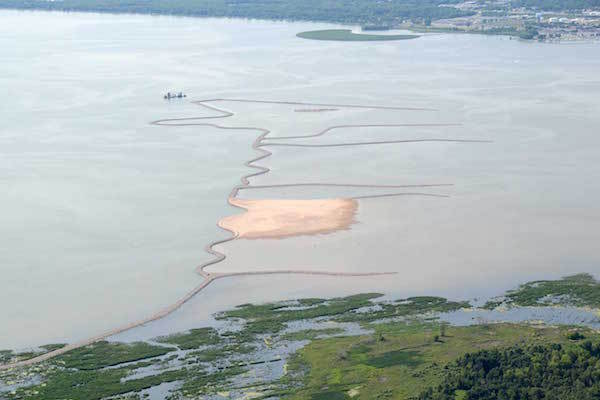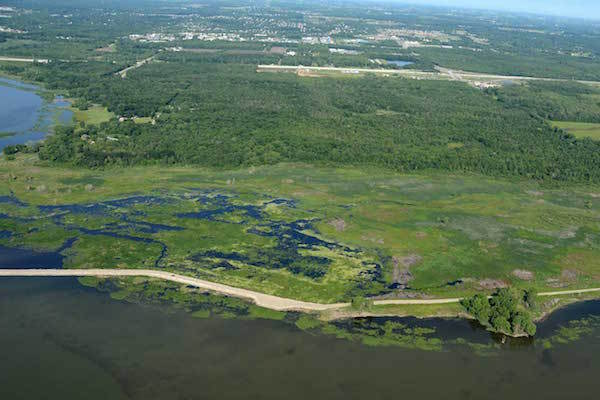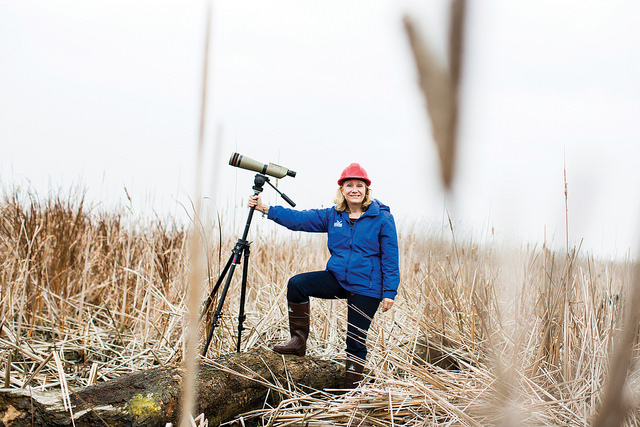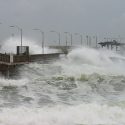Experts help Green Bay establish new island chain to benefit shipping and wildlife


Two views of the restored island chain in Green Bay. Above is the western shore and wetlands known as Peter’s Marsh. Below is the road leading to the restoration work. Photos: Gary Fewless and Bud Harris.
A partnership between the University of Wisconsin–Madison, the shipping industry and other organizations to restore a chain of islands in Green Bay is, literally, for the birds.
As the days shorten in northeastern Wisconsin, many migratory birds take their cue to fly over Green Bay en route to wintering grounds, often stopping along the way on the Cat Island chain. Among them are piping plovers, delicate, two-ounce birds that are increasingly scarce in the Great Lakes region thanks to habitat loss caused by human development. A 2007 survey found only six nesting pairs of plovers in Wisconsin.
Below the Green Bay flight path, ships plow along toward the Port of Green Bay, moving tons of asphalt, coal and other products before icy conditions make transport difficult. The port welcomes more than 170 ships each year and generates an estimated $83 million in annual economic activity.
.jpg)
Piping plovers are delicate, two-ounce birds that are increasingly scarce in the Great Lakes region thanks to habitat loss caused by human development.
Photo: U.S. Fish and Wildlife Service.
Though these two seasonal activities may seem at odds, experts from the University of Wisconsin Sea Grant Institute, housed at UW–Madison, are informing a restoration project centered on Cat Island that they hope will benefit both the birds and the shippers. One of the leading experts is Gene Clark, a Sea Grant coastal engineer who advises shipping industry partners on how to dispose of dredged material in ways that benefit both industry and the environment.
To keep shipping lanes open and viable, the U.S. Army Corps of Engineers regularly dredges channels and harbors, pulling up materials that can include mud, weeds, sand, garbage and more. Shipping operations dispose of these materials in facilities that cost around $30 million to build, says Clark. But if the materials are clean, they could be used instead in construction or habitat restoration projects. And reusing dredged materials rather than storing them yields big savings for shippers.
Fine sands dredged from the Green Bay shipping lanes are being used to fill the length of Cat Island and two smaller, unnamed islands to create a total of 272 additional land acres. So far, the project has established a “spine” and several “fingers” of new land in Green Bay.

Sea Grant’s then-water quality specialist Vicky Harris at the Cat Island site.
Photo: Narayan Mahon.
The initial call for a project of this kind came in the 1970s from former Sea Grant coastal engineer Phil Keillor. He saw Cat Island as a way to reduce waves and sediment re-suspension in the bay. After lower Green Bay was designated an area of concern by the International Joint Commission in the late 1980s, Sea Grant’s then-water quality specialist Vicky Harris led a team of technical and citizen advisory committees. Two years ago, work finally got underway.
“Vicky Harris spent 30 years working with groups to see restoration come to life,” says Julia Noordyk, Sea Grant’s current water quality specialist. “It’s gratifying to work with partners to make this happen and to see Vicky’s, and others’, investment paying off.”

Gene Clark

Julia Noordyk
Eventually, more than 1,400 acres of habitat, both above and below the surface of the bay, will be created. As for the piping plover? In 2014, the bird was sighted 10 times on the emerging islands. Twenty-nine other species of shorebirds are also finding a new haven, including the federally threatened red knot and the endangered gull-like Forster’s tern, which has successfully bred in lower Green Bay for the first time in 20 years.
“The restoration of the Cat Islands is a win-win that demonstrates the economics and environmental benefits of reusing dredged material,” says Dean Haen, director of the Brown County Port & Resource Recovery Department.
Project partners along with UW–Madison Sea Grant include the Port of Green Bay, Brown County, U.S. Fish and Wildlife Service, U.S. Army Corps of Engineers, U.S. Environmental Protection Agency, Wisconsin Departments of Transportation and Natural Resources, Lower Fox River/Green Bay Natural Resource Trustee Council, UW-Green Bay and 14 port terminal operators.
—Moira Harrington
Subscribe to Wisconsin Ideas
Want more stories of the Wisconsin Idea in action? Sign-up for our monthly e-newsletter highlighting how Badgers are taking their education and research beyond the boundaries of the classroom to improve lives.
Tags: environment, industry, The Wisconsin Idea, water, wildlife

